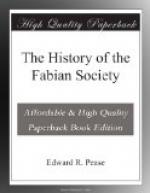At the members’ meeting on September 20 a committee was appointed to prepare an Eight Hours Bill for introduction into Parliament, and in November this was published as Tract No. 9. It consists of a Bill for Parliament, drawn up in proper form, with explanatory notes. It provided that eight hours should be the maximum working day for Government servants, for railway men, and for miners, and that other trades should be brought in when a Secretary of State was satisfied that a majority of the workers desired it. The tract had a large sale—20,000 had been printed in six months—and it was specially useful because, in fact, it showed the inherent difficulty of any scheme for universal limitation of the hours of labour.
The Eight Hours Day agitation attained larger proportions than any other working-class agitation in England since the middle of the nineteenth century. For a number of years it was the subject of great annual demonstrations in Hyde Park. It commended itself both to the practical trade unionists, who had always aimed at a reduction in the hours of labour, and to the theoretical socialists, who held that the exploiter’s profits came from the final hours of the day’s work. The Fabian plan of “Trade Option” was regarded as too moderate, and demands were made for a “Trade Exemption” Bill, that is, a Bill enacting a universal Eight Hours Day, with power to any trade to vote its own exclusion. But the more the subject was discussed, the more obvious the difficulties became, and at last it was recognised that each trade must be dealt with separately. Considerable reductions of hours were meantime effected in particular industries; an eight-hour day became the rule in the Government factories and dockyards; the Board of Trade was empowered to insist on the reduction of unduly long hours of duty on railways; finally in 1908 the Miners’ Eight Hours Act became law; and the demand for any general Bill faded away.
The autumn meetings were occupied by a course of lectures at Willis’s Rooms on “A Century of Social Movements,” by Frank Podmore, William Clarke, Graham Wallas, Hubert Bland, and Mrs. Besant, and with the beginning of the year 1890 we come to the publication of “Fabian Essays,” and a new chapter in the History of the Society.
FOOTNOTES:
[16] On this passage Shaw has written the following criticism, which I have not adopted because on the whole I do not agree with it: “I think this is wrong, because the Fabians were at first as bellicose as the others, and Marx had been under no delusion as to the Commune and did not bequeath a tradition of its repetition. Bakunin was as popular a prophet as Marx. Many of us—Bland and Keddell among others—were members of the S.D.F., and I was constantly speaking for the S.D.F. and the League. We did not keep ourselves to ourselves; we aided the working class organisations in every possible way; and they were jolly glad to




